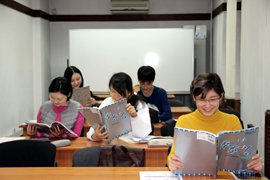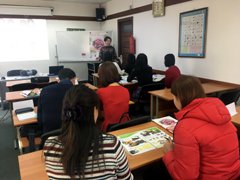A Place for Building Bridges between Japan and Kyrgyzstan
Kyrgyz Republic-Japan Center for Human Development
SAKAMOTO Miharu
When hearing the the name of the Kyrgyz Republic (hereinafter “Kyrgyzstan”), few Japanese people are able to immediately come up with the precise location and image of that country, but in fact, the people of Kyrgyzstan have a very close affinity with Japan, to the point that they even have a saying that “Long long ago, the people of Kyrgyzstan and Japan were brothers, but those who liked meat became the Kyrgyz while those who liked fish moved east and became the Japanese.” The facial features of the Kyrgyz and Japanese are also very similar. Sadly, despite the similarity in appearance, there is little economic exchange between the two countries, and for the people of Kyrgyzstan, Japan is a very distant country that they cannot easily visit. However, that distance is currently shrinking very rapidly, with the entry of the first Japanese company into the country, and just last year, the Kyrgyz soccer team traveled to Japan for a friendship match. As a result, Japan, that distant country at the end of the Silk Road, where legend says the people look familiar, is becoming a much more familiar place. In the past few years, the number of Japanese learners is exploding with strong forward impetus. Whereas previously, Japanese-language education in Kyrgyzstan had primarily been concentrated at higher educational institutions, maintaining a high level of quality, Japanese is expanding into other areas, such as new Shkola (unified primary through junior high schools) that incorporate the teaching of the Japanese language and culture.
Within this background, the place where learners of the Japanese language or Japanese business management, and Japanese people and companies interested in Kyrgyzstan are gathering is the Kyrgyz Republic-Japan Center for Human Development (hereinafter the “Center”). As the Japanese-Language Specialist, my job is to operate the Japanese-language course offered by the Center according to the JF Standard for Japanese-Language Education while also providing support for Japanese-language education overall in Kyrgyzstan for the eventual localization of this expanding field.
To Japan, One Day!
For the past several years, the Center has worked with the Embassy of Japan in Kyrgyzstan to hold a Japanese-language traveling course at local Shkola to expand the scope of Japanese-language education in the country. Perhaps as a result of those activities, there has been a notable increase in teenage learners at our evening Japanese-language course. Many of these young learners are studying to realize their dream of one day attending a university in Japan, but the path to achieve that dream is a narrow one because the economic gap between the two countries means it would only be possible with scholarships from the government or university. Nevertheless, the learners continue to study hard every day, going so far as to visit the Center for self-study on days when there are no classes.
Meanwhile, the Center receives many inquiries regarding our adult learners from international aid programs and companies looking for talented personnel for their programs and business efforts. Many of the adult learners already possess some other skill in addition to Japanese, so they can potentially connect with Japan by leveraging that skill. The Center has also provided Japanese-language training for the Kyrgyz employees of the first Japanese company in the country in collaboration with the Center‘s business course. Accordingly, in addition to the young people who hope to study in Japan one day, the Center also supports learners of Japanese who hope to serve as bridges between Kyrgyzstan and Japan from inside the country.

To Japan, one day!
A New Experience via the “Marugoto: Japanese language and Culture” Seminars!
As Japanese-language education grows rapidly in the country, the immediate problem becomes the shortage of teachers. To be sure, there are highly experienced and talented teachers at the venerable higher educational institutions, but due in part to other social conditions, the environment is less able to cultivate younger teachers.
Also, due to the distance from Japan, the younger teachers typically only know the textbook they learned from, and their only model to emulate is their own teacher. These teachers having been contacting the Center with their desire to learn more about our new “Marugoto: Japanese Language and Culture” (hereinafter “Marugoto”) textbook and how to use it. Accordingly, the Center held seminars in the Kyrgyz capital of Bishkek and the second largest city of Osh.
The seminars attracted primarily younger teachers with a desire for new knowledge and experiences. With an at-home atmosphere, the seminars embodied the Marugoto motto of learning living communication. The participants were able to tackle new classroom experiences with excitement, and even engage in deeper discussions with the instructors who ran the seminars. For the seminars, Kyrgyz teachers working at the Center served as the main teachers in the aim of taking a step towards localization of Japanese-language education in the country, with Kyrgyz teachers training the younger generation themselves, so the use of the Marugoto courseware was likely a new experience for both the teachers and participants of the seminars.
To be sure, experienced teachers cannot be trained in just a seminar of several days. Moving forward, the question of how to support the further growth of Japanese-language education in Kyrgyzstan and the worsening problem of the shortage of teachers will be a major challenge for Japanese-language education in the country and for the Japanese-Language Specialist dispatched here.

A new experience via the Marugoto seminars!
- What We Do Top
- Arts and Cultural Exchange [Culture]
- Japanese-Language Education Overseas [Language]
- Japanese-Language Education Overseas [Language] Top
- Learn Japanese-language
- Teach Japanese-language
- Take Japanese-Language Test
- Know about Japanese-language education abroad
- The Japanese-Language Institute, Urawa
- The Japanese-Language Institute, Kansai
- Japanese-Language Programs for Foreign Specified Skilled Worker Candidates
- Japanese Language Education for Japanese Children Resident Overseas and for the Descendants of Migrants
- Archives
- Japanese Studies and Global Partnerships [Dialogue]
- JF digital collection
- Other Programs / Programs to Commemorate Exchange Year
- Awards and Prizes
- Publications
